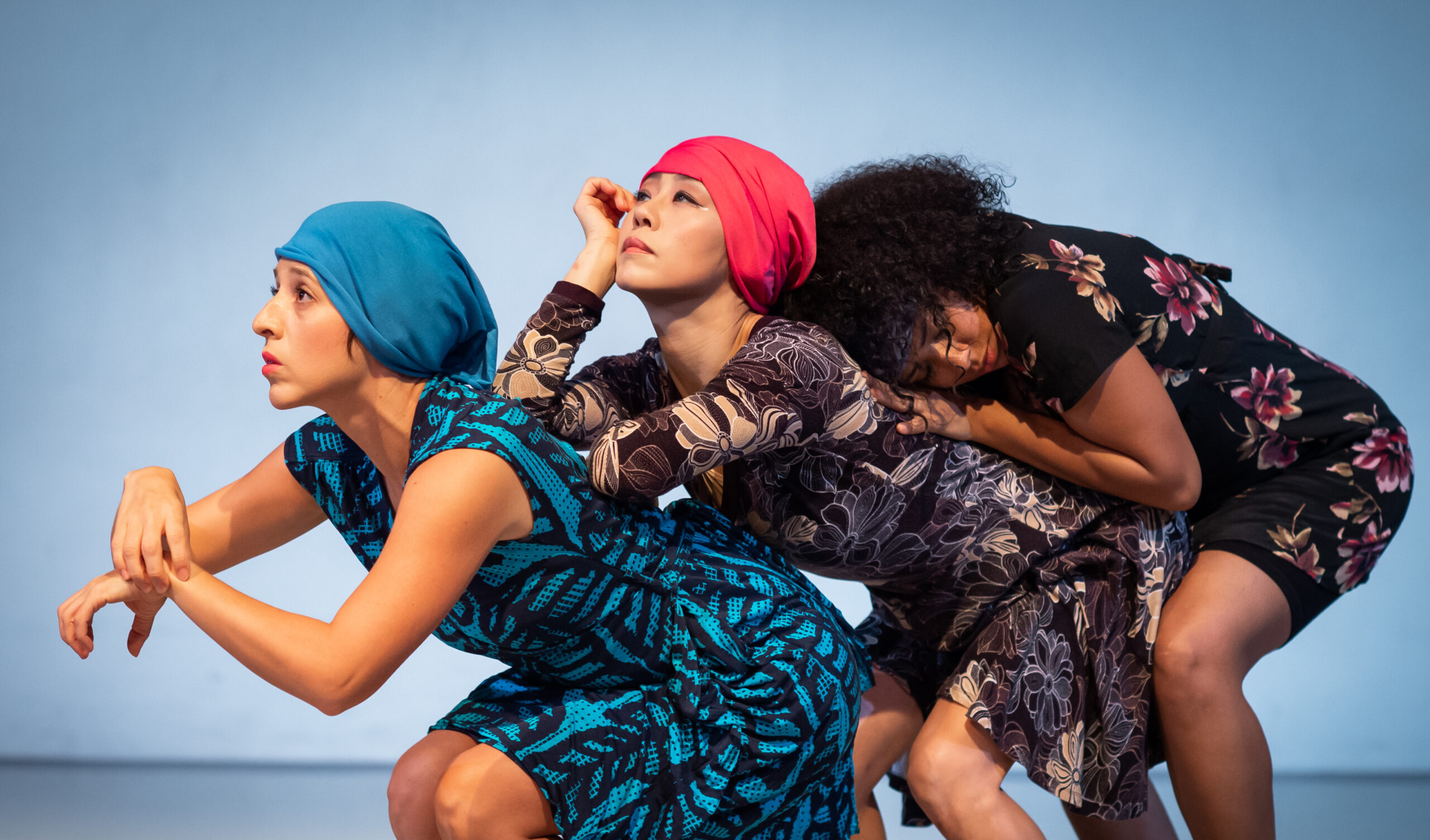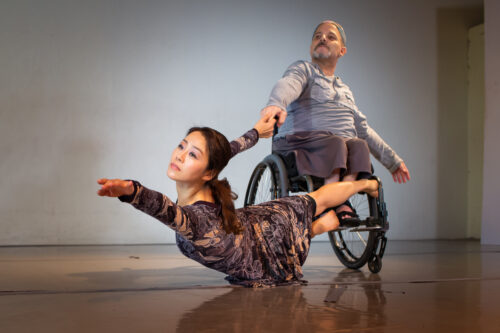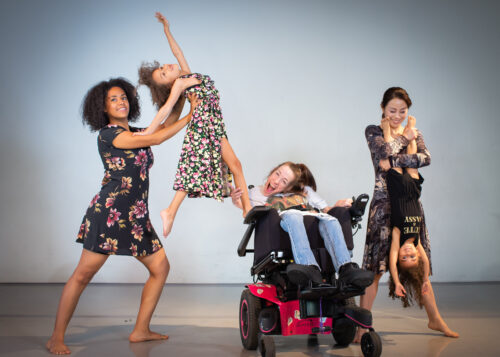Dance
Karen Peterson and Dancers reflects on cycle of life in ‘Samsara’

Penelope Huerta, Sun Young Park and Barny Espinal make up a cast of eight adults performing in KPD’s “Samsara.” (Photo/Lisa Nalven)
Anyone who enjoys exercise or sports can remember moments when aches and pains prompted a change of routine. For choreographer Karen Peterson, decades of dance eventually led to twin hip replacement surgeries. But after recovery, she experienced a freedom in movement she hadn’t felt in years.
“I rediscovered the joy of movement when I again had everything working and did not have pain anymore,” said the artistic director of Karen Peterson and Dancers (KPD), one of Miami’s foremost physically integrated dance companies. “I have three grandchildren and I’m getting older, and some of my dancers are getting older, and so I began reflecting about the cycle of life.
“We are all going to the same place in the end, whether we have one or two legs, one or two arms.”
Her recent experience of post-op physical renewal — alongside discussions with her dancers about familial life and parental memories — are at the heart of KPD’s latest program, “Samsara” (the Sanskrit term referring to the cycle of life). With three mothers in her company, “Samsara” places special emphasis on the theme of family.
“This program is a narrative inspired by sharing very personal stories about our families,” Peterson said. “We realized we had the family of Karen Peterson Dancers, but we also had our own original families. Of course, a lot of love comes out when sharing about that subject, but also fear and distrust. We take those personal histories and put it in our bodies.”

Sun Young Park and Adam Eckstat. (Photo/Lisa Nalven)
Peterson sampled gestures and movements from improvising on those histories in the studio and made them the basis for her choreographies. Inspirations for the movements began with the mothers among the dancers and then were passed on to the rest of the company. Peterson decided to incorporate three of the dancers’ daughters, all younger than age 5, by giving them a loose improvisational structure and pairing them with their mothers for the performance.
She also turned for inspiration to the Gaga dance technique, developed by Ohad Naharin, artistic director of the Israeli dance company, Batsheva. Naharin’s large, improvisational classes encourage students to generate movements from an inside place.
“Gaga is very physical and very taxing, and [Naharin] holds these improvisational sessions for people in wheelchairs. I was asking the dancers to relearn their bodies and how to communicate physically,” she said.
“During Naharin’s classes, company members move so freely and give off the feel that they are totally aware of every bone in their body and every muscle,” Peterson continued. “They move with 100 percent of their physical self. He reminds the class that they are not pieces of furniture. Everything is totally connected.”
Peterson finds this to be especially true for wheelchair dancers.
“For PI (physically integrated) dance, it’s about one’s physicality in the chair – there is life in your spine and life in your ribcage, so it’s about relearning how to be a physical dancer,” she said. “After I convince a dancer with a disability that they can be a dancer and expressive mover, we begin to think about how they can make their body an expressive tool. I’m trying to give the dancers a new sensation.”
The cast of “Samsara” includes eight adult dancers – Penelope Huerta, Barny Espinal, Sun Young Park, Adam Eckstat, Marjorie Burnett, Lisa Sandelin, Shawn Buller, and Monica Lynne – and three children: Sara Sofia Vasquez Huerta, Eleah Espinal and Julissa Espinal.
COVID-19 recovery money from the National Endowment for the Arts (NEA) gave the company some extra support.
“Recovery money from the NEA has been helpful to give us some extra time for rehearsal in the studio than we might have had in the past when preparing a program,” Peterson said.

Barny Espinal with Eleah Espinal, 6, along with Marjorie Burnett and Sun Young Park with Julissa Espinal, 2. (Photo/Lisa Nalven)
The hourlong “Samsara” also includes video elements created by Miami visual artist Maria Lino.
“I’ve been doing video art since the mid-’70s as part of my interest in the visual arts,” Lino said. “For ‘Samsara,’ I watched the different rehearsals and concentrated on what the choreography was trying to say. I requested the dancers be dressed in black with red scarves, and we’d arrange the rehearsal space.
“I tried to show close-ups of the hands, faces, and also high angles – viewpoints the audience usually doesn’t get to see. Then I’d enhance elements like lighting in the editing process,” she added.
The current program represents Lino and Peterson’s fifth collaboration. Their last project, “Warmamas,” debuted at the storied Judson Memorial Church in New York’s Greenwich Village in 2019.
“Maria Lino shot a lot of footage [for ‘Samsara’], and then she would pick and choose moments from the choreography. She then expanded and played with them,” Peterson said. “Some of the images fade in and fade out, they are very abstracted, or they may occupy a part of the screen … They are sometimes integrated into the dance and sometimes she makes a video statement that stands on its own.”
WHAT: Karen Peterson & Dancers presents world premiere of “Samsara”
WHEN: 8 p.m. Feb. 18-19, 2022
WHERE: Miami-Dade County Auditorium’s On.Stage Black Box, 2901 W. Flagler St., Miami
COST: $25 for general admission; $20 for students and seniors
SAFETY PROTOCOLS: The venue is requiring that masks be worn when attending indoor performances. For details, visit miamidadecountyauditorium.org/coronavirus-updates.
INFORMATION: 305-298-5879; KarenPetersonDancers.org
ArtburstMiami.com is a nonprofit source of theater, dance, visual arts, music and performing arts news. Sign up for our newsletter and never miss a story.
